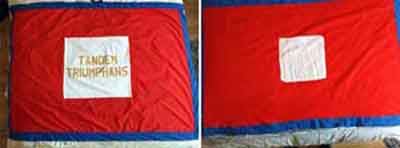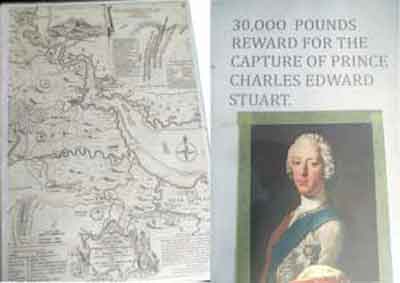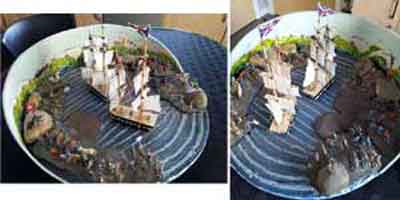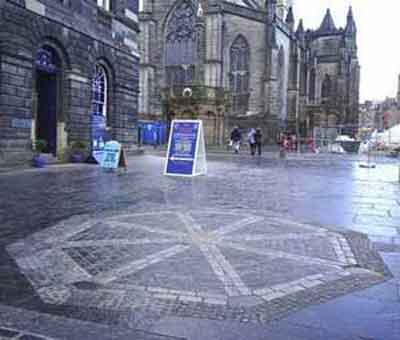 This cavalry guidon was captured from Colonel Gardiner's 13th Dragoons at Falkirk
John Daniel, an English volunteer serving in Balmerino's troop, recorded that at Elgin it was given a curious fine Standard with the motto Britons Strike Home. British cavalry standard 's of this period are poorly documented comparing them with surviving examples that most had a union flag in the Canton and regimental motto or device on the flag. John Daniel saved the flag from being recaptured in the aftermath of CULLODEN but his riding jacket and flag were stolen by two deserters from the Irish Piquet. |
|---|
 HRH Prince Charles Edward Stuart, 1720-1788 The Prince left France for Scotland on the 7th July 1745. On board the 'Du Teillay' accompanied by an escort ship the 'Elizabeth'. On the 9th of July they were intercepted by HMS Lion of the Royal Navy. An intense naval gun battle ensued which lasted four hours. Both French Ships managed to escape , but the ' Lion ' was badly damaged in the engagement. The 'Elizabeth' was also damaged and returned to France. The 'Du Teillay' unscathed sailed on with the Prince and landed on the Isle of Eriskay on the 23rd. July 1745. He was advised to return home to France. He responded "Sir, I am come home" and on the 19th August 1745 the Prince's Standard was raised at Glenfinnan and the rest is history. |
|---|

 Naval Skirmish on the River Forth 9th-10th January 1746. Prelude to the Battle of Falkirk Muir on January 17th 1746. It was obvious to the inhabitants around the River Forth at Stirling, Alloa, Airth and Falkirk that the Jacobite army under the command of Lord George Murray were using this part of the river as a crossing point to supply the troops assembling at Bannockburn and the surrounding area. Hanoverian spy and government tax and custom officer Walter Grosset was asked by the Lord Justice Clerk in Edinburgh to try and stall the Jacobite army here by deploying two sloops of war from Leith. The Vulture and The Pearl supported by armed boats carrying troops, the Happy Jennet and the Jean of Leith and another out of Kinghorn. The flotilla set sail up the Forth and managed to set fire to two skiffs that the Jacobites had anchored at The Pow estuary, near Airth. They deployed their Redcoat marines under the command of a Colonel Leighton at Kincardine whose aim was to outflank the Jacobite forces at Alloa, unfortunately the Jacobite force here had been strengthened by 300 Camerons and the government force retreated back to Kincardine and boarded their troop transports back to Leith. The troops on the Airth side of the river, under cover of darkness, reached Kersie Mains House where they thought Lord Elcho was staying, unfortunately he had left the house earlier to command the Artillery emplacement at Elphinstone-Pans. They returned to their boats and reached the two sloops Vulture and the Pearl which were now stuck on a sand bank mid river on the low tide. The Jacobite artillery now alerted to these actions opened fire on the sloops who returned fire and in the ensuing fire fight there were casualties on both sides. The Royal Navy had the pilots of their sloops mortally wounded and later died and are reputed to have been buried at or near Higgins Nuek ferry. At high tide the two sloops sailed down the river back to Leith leaving the upper Forth under Jacobite control. History tells us that if the government troops had been a little bit braver and been more adventurous, that if they had gone a little more inland, their main enemy and wanted man, with a price of £30,000 for his arrest and capture, was convalescing at BannockburnHouse being looked after by Lady Clemintina Walkinshaw. |
|---|
 Jacobite Standards that were saved from being captured< At least Seven Jacobite Standards that were carried onto the battlefield of CULLODEN were saved from being captured. These were :
|
|---|
 Jacobite Flags that were burned by the public hangman, John Dalgleish, on Wednesday 4th June 1746 Fourteen Jacobite Colours were reported to have been captured at CULLODEN. Descriptions survive on a receipt given for them by a Major Hu Wentworth of the 6th Foot on the 11th. May 1746. Soldiers who had captured Jacobite banners were paid Sixteen Guineas each The Flags were carried to the merkat cross by chimney sweeps and low life members of Edinburgh flanked by an escort of foot soldiers. A senior herald read out the proclamation that “These scraps of silk and braids be burn't by the Public Hangman by order of HRH the Duke of Cumberland" (the butcher). Each Banner was named then held over the flames.
|
|---|
